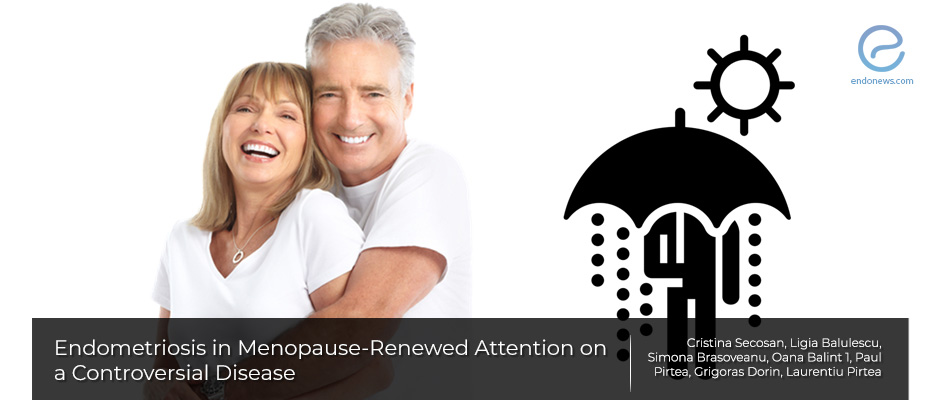Postmenopausal endometriosis: Is it a rare phenomenon?
May 21, 2020
The belief that endometriosis is a reproductive-aged disease has changed resulting in the development of the concept of postmenopausal endometriosis.
Key Points
Highlights:
- Although the underlying cause of postmenopausal endometriosis is still not known, it is important to know its occurrence in this age group.
Importance:
- Postmenopausal women with suspected symptoms of endometriosis should be carefully evaluated for the differential diagnosis of endometriosis and malignant disease.
What’s done here?
- This review was conducted to emphasize that endometriosis could be diagnosed in the postmenopausal period.
- There is scarce information on postmenopausal endometriosis in literature as endometriosis is known as a disease of reproductive-aged women.
- This review includes data about the prevalence, pathophysiology, clinical presentation, diagnosis, and management of postmenopausal endometriosis.
- Additionally, the risk of malignant transformation of endometriosis and the presence of extrapelvic endometriosis in postmenopausal women are also clarified.
Key results:
- Endometriosis is diagnosed in the postmenopausal period, incidence ranging from 2 to 5%.
- It may develop in postmenopausal women who used hormone replacement therapy or tamoxifen. However, postmenopausal endometriosis has more complex pathophysiological mechanisms despite the limited literature data.
- The most accepted theory is the estrogen threshold theory: the excess estrogen resulting in the development or activation of endometriotic lesions.
- The main source of estrogen in the postmenopausal period is peripheral tissues including adipose tissue and skin.
- Another reason for the increased estrogen level is the external estrogens (hormone replacement therapy or phytoestrogen).
- The symptom spectrum is similar for premenopausal and postmenopausal women. However, care should be taken to differentiate endometriosis and malignancy in the postmenopausal period.
- The gold standard for diagnosis is the same for both: surgical removal and histopathological confirmation.
- There is currently no validated biomarker with high sensitivity and specificity for the diagnosis of endometriosis.
- Laparoscopy provides the chance for both diagnosis and treatment in these patients with postmenopausal endometriosis.
- Medical treatment such as hormone replacement therapy, tibolone, tamoxifen, or aromatase inhibitors can be recommended who do not have contraindications to use these medications.
- The women having postmenopausal endometriosis have an increased risk of ovarian carcinoma, with an estimated rate of 2-3%.
- The extrapelvic location of endometriosis such as the gastrointestinal tract, the urinary tract is extremely rare in this age group based on the limited data.
Lay Summary
Endometriosis, the estrogen-dependent disease defined as the localization of endometrial glandular and stromal tissue outside the uterine cavity, is generally diagnosed in the reproductive-aged women. However, recent literature proved that this disease can also be observed in the premenopausal and postmenopausal periods.
Secosan et al, scientists from Romania and France, published a review titled “Endometriosis in Menopause—Renewed Attention on a Controversial Disease” in the journal named "Diagnostics". The authors aimed to evaluate postmenopausal endometriosis in all aspects, including the prevalence, pathophysiology, clinical presentation, diagnostic and treatment methods, risk of malignant transformation, and presence of extrapelvic endometriosis.
The main underlying mechanism for postmenopausal endometriosis is the estrogen threshold theory: Excess levels of estrogen result in the development or the activation of endometriotic lesions. The two sources of estrogen in the postmenopausal women are peripheral tissues such as adipose tissue, skin, and external hormones such as hormone replacement treatment.
Pelvic pain, ovarian cysts, intestinal or urinary symptoms are the most common complaints as in premenopausal women. However, the clinicians should be careful as the severity of symptoms and clinical presentation are not correlated. The anamnesis, clinical evaluation, and physical examination of the patients can assist the clinicians in determining postmenopausal endometriosis to a limited extent.
The gold standard for diagnosis is surgical removal and histopathological confirmation, but the researchers have been trying to develop new non-invasive diagnostic methods. Although promising non-invasive biomarkers have been detected, there is still no biomarker with high sensitivity and specificity validated for the diagnosis of endometriosis in clinical practice.
Some imaging methods can be used to differentiate postmenopausal endometriosis. Transvaginal ultrasonography is the first-line imaging method with several advantages including lack of exposure to radiation, wide availability, cost efficiency, and well tolerance. Other imaging methods such as computed tomography, magnetic resonance imaging, or double-contrast barium enema provide information for the differential diagnosis of deep infiltrating endometriosis and endometriomas.
Despite extensive research, the optimal management of endometriosis also still remains unclear. The decision for treatment should be patient-centered considering the patient’s clinical presentation, age, the severity of symptoms, disease extent and location, other comorbidities, side effects and complications related to medical treatment and surgery, and cost. Medical treatment such as hormone replacement therapy, tibolone, tamoxifen, or aromatase inhibitors can be recommended who do not have contraindications to use these medications. Postmenopausal women with suspected symptoms of endometriosis should be investigated carefully for the differential diagnosis of malignant disease due to the increased risk for ovarian carcinoma in these patients.
“Despite its relatively low incidence, physicians should consider endometriosis in cases of unclear pelvic pain in postmenopausal patients, even if the patient has no prior history of endometriosis.” the authors added.
Research Source: https://pubmed.ncbi.nlm.nih.gov/32121424
endometriosis menopause postmenopausal women diagnosis management malignancy laparoscopy endometriosis abdominopelvic cavity bowel endometriosis endometriosis feel like back pain

